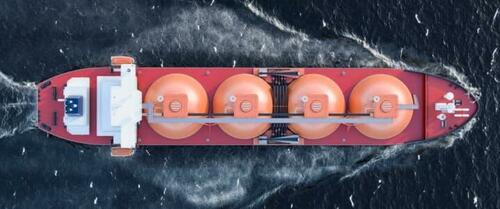
By Tsvetana Paraskova of OilPrice.com
More than 30 tankers carrying $2 billion worth of LNG are currently idling off Europe’s coasts as regasification terminals are full and traders expect European natural gas prices to start rising again as winter approaches, the Financial Times reported on Friday, quoting data from energy flow analytics company Vortexa.
According to Vortexa’s head of LNG, Felix Booth, the tankers idling off the coasts of northwest Europe and off Spain and Portugal currently have an incentive to stay where they are, waiting for higher gas prices in the coming weeks and months.
Last month, Spain declared an “exceptional operational situation” as several dozen LNG tankers queued for its regasification terminals, significantly exceeding available slots. The tanker pileup highlights Europe’s problem with LNG import capacity that prompted Germany to urgently strike a deal for the construction of two floating facilities so it can receive LNG directly.
In recent weeks, Europe’s benchmark natural gas prices at the Dutch TTF hub have slumped to the lowest in four months, as comfortable storage levels, the high rate of LNG imports, and the mild weather in October and early November have eased concerns about gas supply and demand balances in the early part of the heating season. As of November 2, gas storage sites in Europe were 95% full, with German storage at 99.3% full, according to data from Gas Infrastructure Europe.
Although prompt-month futures prices have dropped, the forward curve is in a state of contango, with December prices and prices through March much higher, giving incentive to traders to hold onto the LNG tankers until prices rise again.
Early on Thursday, gas prices jumped by 10% as weather forecasts pointed to a colder-than-normal spell coming to northwest Europe by December. With the inevitable turn of the weather after a warm October, speculation returned over how fast storage levels could be depleted this winter and whether winter demand from Asia will intensify the competition with Europe for LNG supply.
By Tsvetana Paraskova of OilPrice.com
More than 30 tankers carrying $2 billion worth of LNG are currently idling off Europe’s coasts as regasification terminals are full and traders expect European natural gas prices to start rising again as winter approaches, the Financial Times reported on Friday, quoting data from energy flow analytics company Vortexa.
According to Vortexa’s head of LNG, Felix Booth, the tankers idling off the coasts of northwest Europe and off Spain and Portugal currently have an incentive to stay where they are, waiting for higher gas prices in the coming weeks and months.
Last month, Spain declared an “exceptional operational situation” as several dozen LNG tankers queued for its regasification terminals, significantly exceeding available slots. The tanker pileup highlights Europe’s problem with LNG import capacity that prompted Germany to urgently strike a deal for the construction of two floating facilities so it can receive LNG directly.
In recent weeks, Europe’s benchmark natural gas prices at the Dutch TTF hub have slumped to the lowest in four months, as comfortable storage levels, the high rate of LNG imports, and the mild weather in October and early November have eased concerns about gas supply and demand balances in the early part of the heating season. As of November 2, gas storage sites in Europe were 95% full, with German storage at 99.3% full, according to data from Gas Infrastructure Europe.
Although prompt-month futures prices have dropped, the forward curve is in a state of contango, with December prices and prices through March much higher, giving incentive to traders to hold onto the LNG tankers until prices rise again.
Early on Thursday, gas prices jumped by 10% as weather forecasts pointed to a colder-than-normal spell coming to northwest Europe by December. With the inevitable turn of the weather after a warm October, speculation returned over how fast storage levels could be depleted this winter and whether winter demand from Asia will intensify the competition with Europe for LNG supply.





